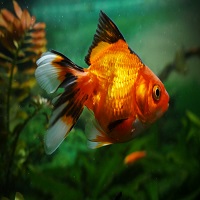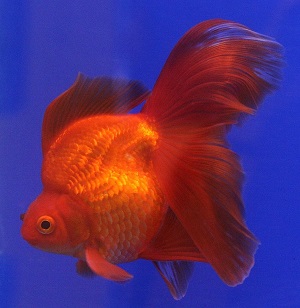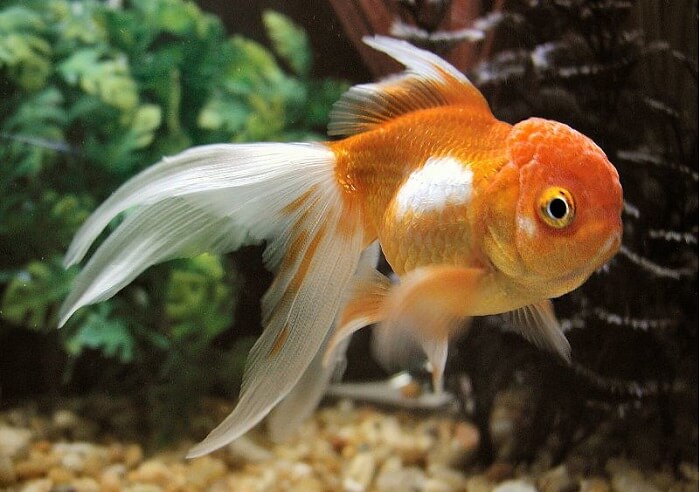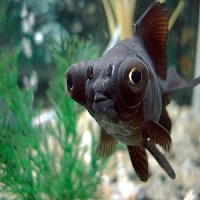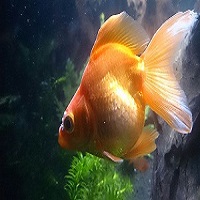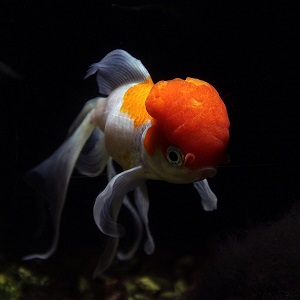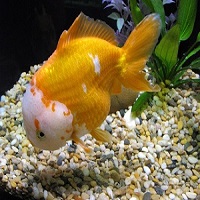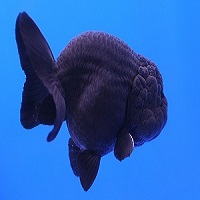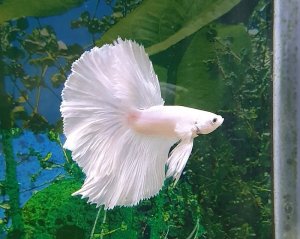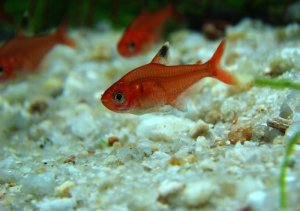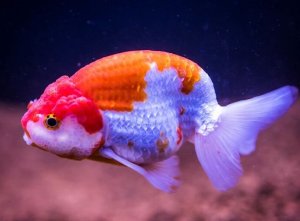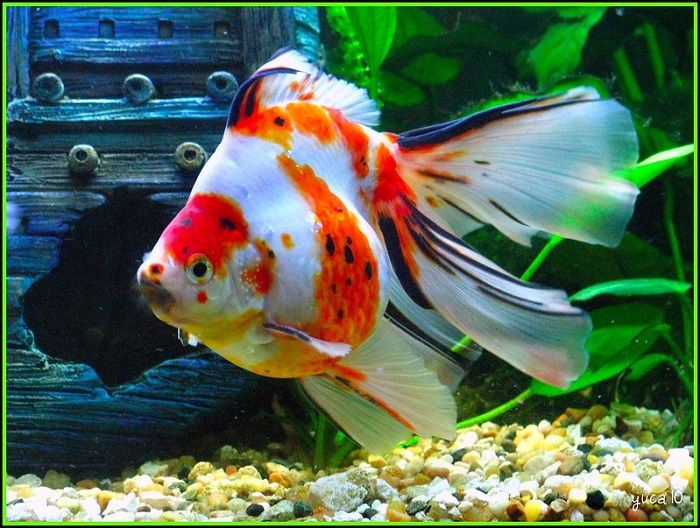
Breed Overview
| Origin | China. |
| Lifespan | 10 -15 years in Captivity. |
| Size | The Ryukin Goldfish can reach sizes of between 6 – 10 inches, or up to around 25cm. |
| Colour | Deep Red (Most Common), red and white, white, silver, silver blue, black, orange, lavender, gray, iron, and calico coloration (More Rare). |
| Food | Omnivorous. |
| Tank Size | Bare Minimum is 10 Gallons per Ryukin, 20-30 gallon tanks is advised, and 10 gallons extra per additional Ryukin. |
| Temperament | Semi-Aggressive Towards Smaller Breeds, Social, Active. |
| Water Type | Freshwater. |
| Water Temperature | 65-72 degrees F/18-22 degrees C. |
| Water pH | 6.0 to 8.0, the best is to stay between 6.5-7.5 to be completely safe. |
| Difficulty Level | Informed Beginner, Easy Care. |
Ryukin Species Information
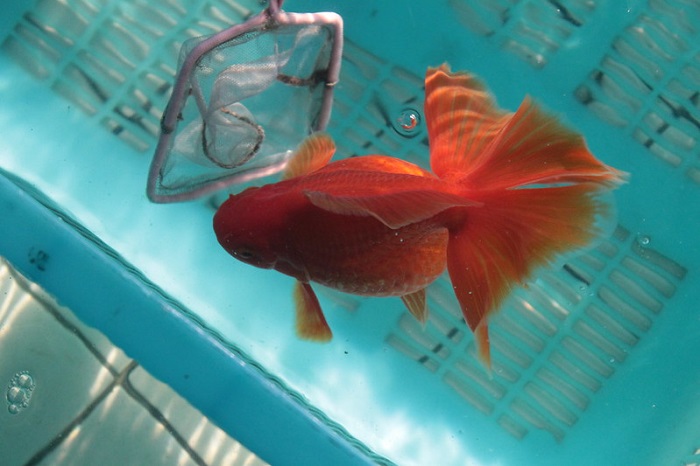
The Ryukin Goldfish, originating from the Ryukyu Islands, as noted in Wikipedia, is a gorgeous ornamental Goldfish with a Japanese variety of the Fantail with a few different features. The Ryukin Goldfish Size is quite remarkable and makes it robust and easy to care for Goldfish for beginners.
As with most Goldfish breeds the Ryukin Goldfish is likewise obtainable in several color variations.
They are attractive and very hardy goldfish. If they should captivate you, then read further to learn much more about this majestic Goldfish breed.
Fantail Goldfish VS Ryukin Goldfish
As you have most likely heard the Ryukin Goldfish is said to be a “Japanese variety of Fantail Ornamental Goldfish”, though there are quite a few differences between the two Goldfish breeds;
Fantail Goldfish |
Ryukin Goldfish |
|
|
|
| The Fantail GoldFish has an egg shaped body, and only one fin that is single, the dorsal fin. The fantail Goldfish has paired fins, and a caudal fin with a split down the middle resembling a fork on each fin. When you view the tail from above it looks similar to a fan, hence the name “Fantail goldfish” | The Ryukin Goldfish on the other hand, is a popular breed in Japan that has similarities to the Fantail. It is contrasting with the prominent hump on the back of its head which also raises the dorsal fin. The Ryukin has a caudal tail fin that may have three or four lobes, resembling what the Japanese refer to as a ‘Cherry Blossom Petal tail” |
Different Color Variations Of The Ryukin Goldfish
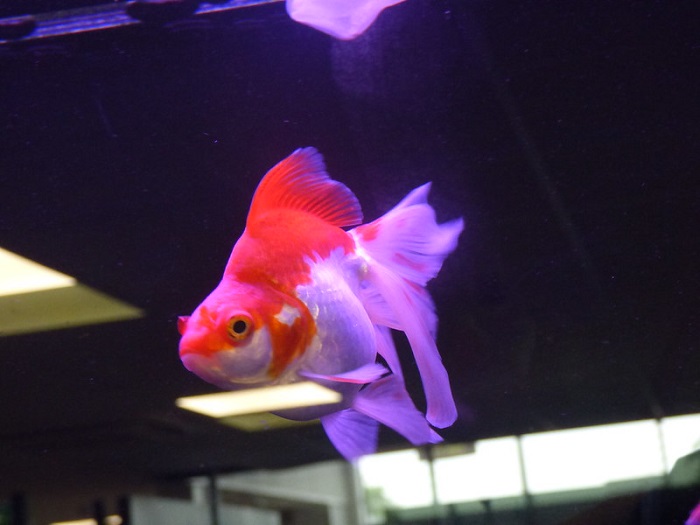
Similar to other Goldfish breeds such as the kindred Fantail, the Ryukin Goldfish does come in a few main color varieties;
- Deep Red – The Deep red is the most common color with a dark reddish-orange appearance.
- Red and White – The color is a mix of dark red and white, where the red will usually be the most prominent.
- Orange – The orange color is similar to most common orange goldfish, yet not so common a color in the Ryukin.
- White – The pure white has no other colorations and is pearlescent, almost see-through white. Some white colors may have slight markings of black, orange, or red.
- Silver – Silver is almost similar to white with slight gray markings and shading on the scales.
- Blue – The blue variant is not an actual blue, but rather a very deep and dark gunmetal gray.
- Black – Similar to the blue, the black is not a solid matt black such as with Moors, but rather a faded brownish black color.
- Lavender Grey – The Lavender gray is much similar to silver, with a tinge of lavender on the scales.
- Brown – The brown will be a deep golden brown or a darker chocolate brown color. Calico – As you will see from our first theme image, the Calico usually has a white or orange base with two other colors.
Ryukin Goldfish Size
You might have heard of the phrase “Jumbo Ryukin Goldfish”. The Ryukin Goldfish is substantial in size, compared to other Fancy breed tanks Goldfish.
The Ryukin Goldfish can grow up to between 6-7 inches in a standard-size tank, in larger tanks it can reach up to 10 inches in size.
What you have heard about the size of the tank affecting the growth of your goldfish is more of a myth. Most Fancy Goldfish breeds will grow because of the quality of water rather than the size of the tank, this is why they seem to have a growth spurt when placed into a new larger tank.
Keeping Ryukin Goldfish In General
|
|
First of all, you need to take note that Goldfish, in general, are not similar to tropical fish when it comes to caring, especially with water temperature, they prefer colder temperatures and are ideally easier to care for.
The Ryukin Goldfish, though a fancy Goldfish breed, is extremely robust, large in size, and relatively easy to care for, taking care that they are kept in an aquarium that is fully cycled and very well maintained. The Ryukin can be kept with some breeds of Goldfish as tank mates though they may be slightly on the competitive side. |
The Ryukin can reach sizes of up to 10 inches and can live anything between 10-15 years, 20 years at most. Thus they are a long-term and “big” responsibility. The Jumbo Ryukin Goldfish will generate large amounts of waste and has quite an appetite in accordance with its size.
Ryukin goldfish have slightly different needs than most Goldfish, so, let’s dive into the wonderful world of Ryukin Goldfish.
Setting Up Your Tank
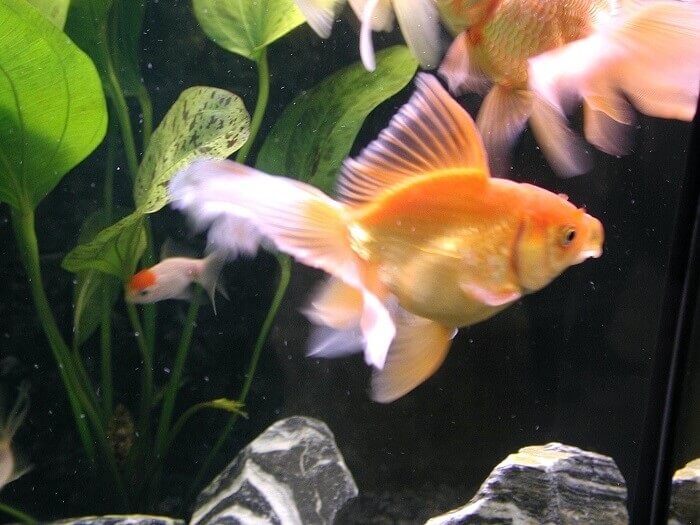
If you are already “hooked” on the magnificent and sizable Ryukin, wait before you dive in and purchase your first fish. It is essential that you invest in a proper Aquarium with all the right trimmings for your new finned friend.
So, let us start off with an easy tank setup;
1. Selecting The Right Sized Tank
You will most probably hear that a single Ryukin only needs a tank of around 10 gallons, though according to research this is the bare minimum.
I would highly recommend a tank of 20-30 gallons, which allows your fish much more space to explore. Should you get more than one Ryukin Goldfish, the rule of thumb is 10 gallons extra per fish.
2. Where To Place Your Tank
Find an area in your home that does not get direct sunlight, or that is near any heating, or cooling vents or systems as you need to keep a constant temperature. Keep in mind should you want to decorate your tank with live plants, they will need indirect sunlight.
Keep your aquarium in an area that it will not get bumped into easily, or be in the way of heavy traffic where the fish may be disturbed frequently.
3. Water Conditions And Filtration
Now, to be very clear, Ryukin Goldfish will not thrive in water conditions that are designed for keeping freshwater standard tropical fish. The Goldfish breed is a Cold water fish thriving in lower-than-normal water temperatures, so you will need to use a tank thermometer to test the water frequently.
According to Specific Scientific research from the Researchgate website, these are your Goldfish water temperatures and parameters;
- Water temperature should be between 18-24 degrees Celsius or 64 – 75 Fahrenheit.
- pH Levels are ideal at pH 6.5 – 7.5, though between 6-8 is acceptable.
- Water Hardness needs to be around 5 to 19dGH, with 0.1 ppm Ammonia, 0.1 ppm Nitrite, and 75 ppm Nitrate.
In General, Goldfish are quite dirty little creatures that create plenty of waste, and Ryukin Goldfish even more so, thus you need an efficient Filtration system that will circulate water throughout your tank, at least four times every hour to manage the mess.
Be mindful that fancy Goldfish are poor swimmers, and a powerful filtration system may generate a strong current throughout the tank. To curb this, try a filter unit that has more of an adjustable outflow, or use a plant or ornament to buffer the current.
Goldfish in general, especially Fancy Goldfish enjoy highly oxygenated water and it keeps them in good shape, so you might need something like an air bladder. Some live plant species similarly generate oxygen in your tank.
4. Creating A Cheerful And Healthy Environment
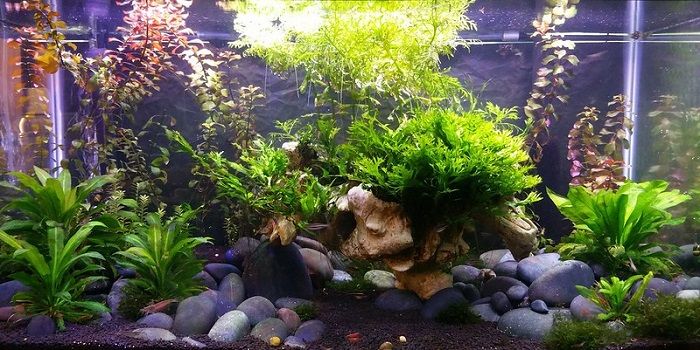
Now comes the fun part, decorating your Ryukin’s tank!
In my personal opinion, these fish are more elegantly displayed with a natural background and decorations, though the choice is yours.
You do get some lovely natural or, “not so natural” background decals that you can place on the back of your tank, along with a vast variety of decorative rocks, plants, ornaments, and colorful, or neutral gravel types.
- Safety First
Most fancy Goldfish, the long-tailed Ryukin especially, are quite clumsy, so stay clear of sharp and rough ornaments that could cause an injury or damage their fragile tails and fins.
Rather opt for smoother pebbles and driftwoods, that resin ornaments with hard and sharp surfaces.
- Substrate For Ryukin Goldfish
The Substrate that you use for your fish is the gravel that you will place at the bottom of the tank. The gravel provides filtration and is also a base for planting aquarium plants.
Because the Ryukin Goldfish is a larger breed of Goldfish it is advisable to use large gauge gravel, almost the size of a pea, so that they do not swallow or choke on the gravel.
- Plants And Other Decor
Depending on the style and theme of your tank you can use the following as decorations, being cautious of anything with rough or sharp edges;
- Driftwood
- Rocks
- Ornaments such as castles and Shipwrecks
- Castles for Shelter
- Plastic Plants
- Living Plants
Living Plants are an excellent choice for a Ryukin tank, they are generally softer than plastic or synthetic plants, they use nitrate as a natural fertilizer, they remove carbon dioxide in your tank and produce oxygen. So if you want to read further about Live plants for Goldfish tanks, find this site keeping “Gold Fish According to Nature” particularly interesting.
5. Lighting In Your Tank
Though the Ryukin Goldfish do need light in their tank for survival, they do enjoy the clear day and night cycles. Daylight encourages them to be active, feed and start spawning, whereas darkness encourages them to sleep.
On the other hand, if you have live plants in your tank you will need some light for photosynthesis, in which case you could opt for an Aquarium lighting unit with an auto timer, or indirect sunlight.
Placing Your Goldfish Into Water
I am sure by now you are very excited to add your new Ryukin Goldfish to the tank, or, to go out and choose the perfect specimen for your tank;
Choosing A Healthy Goldfish
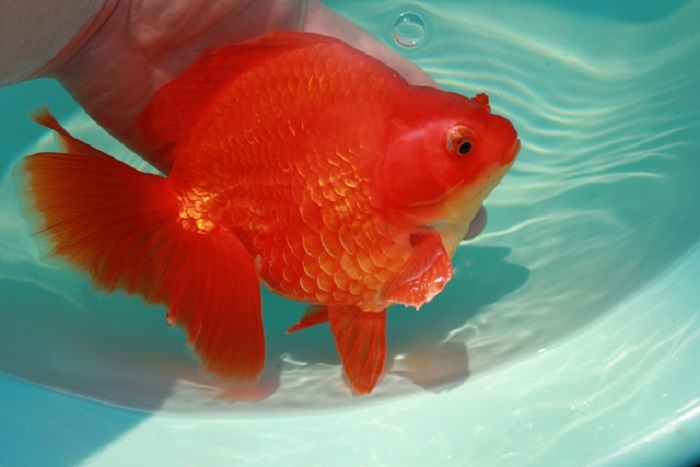
Here are a few steps to help you choose the perfect Ryukin Goldfish;
1. Check The Shape Of The Body
The Ryukin has a very unique body that is egg -shaped and short, with a round belly, and a more prominent dorsal hump. The Ryukin should not have a large stomach and the head, body and tail must be proportional.
2. Check The Fins And Tail
The Fin and the Tail of the Ryukin are what give it its majestic and flamboyant appeal. Pick one that has upright fins that are not bent or damaged in any way.
3. Watch Their Swimming Style
Goldfish that are sluggish and low may have health issues, thus try to pick one that is more active and agile. Furthermore, avoid any goldfish that swims upside down, this is not a cute antic!, it may have a condition called swimming bag, or swim bladder.
4. Consider Their Color
The Ryukin is well known for its gorgeous color diversity, so even if observing the color should not be a concern you can still look for the most attractive and bright color.
Did you know that you can actually brighten or improve their colors by feeding them Spirulina or astaxanthin?
5. Quality VS The Price
A higher priced Ryukin Goldfish does not always mean better quality, though as a fancy breed goldfish, they are more expensive. The price may also depend on the rarity of the color. As long as you follow the tips for choosing the right fish, you will be able to grow a perfectly attractive Ryukin Goldfish.
Placing Your Ryukin In Its New Home
All fish have a protective slime coating, and when they are netted or handled for transfer or when purchased, the slime coating is rubbed off, making them more fragile.
Rehoming a Ryukin Goldfish does cause some stress, and adding additional water conditioners to their new home can help to relieve some stress.
You will receive your new Ryukin Goldfish in a transparent plastic bag filled with water from its old tank.
Before adding the fish to your tank, allow the bag with the fish to float in the water for around 10 minutes so that it can adjust to the water temperature.
Now you can open the bag and add water bit by bit every five minutes for an hour before you can release your fish into the new tank.
When releasing your new Goldfish into the tank try to do so without allowing too much water from the bag into the new tank, as it may contain fish waste.
Selecting Tank Mates
Most Ryukin Goldfish do well, and even enjoy having a tank mate, as they are quite social GoldFish species. Though they are alright on their own, they will be more playful and active with a few friends to keep them company.
You can either get one or more Ryukin Goldfish, depending on the size of your tank or other breeds of Fancy Goldfish that they will get along with.
When it comes to adding a different species of fish to your tank, you should try to stick to dual-fin fish, as Ryukin Goldfish can show aggression towards faster single-fin varieties of fish.
Choose Tank mates that are similar in size to the Ryukin and that are more docile, although they should still be strong enough to defend themselves should the RYukin try to start a fight.
Try to avoid weaker Goldfish breeds such as Celestial Goldfish, and especially Bubble Eyed Goldfish.
You can Introduce these tank mates to your Ryukin;
| The Black Moor
|
The Fantail
|
| The Lionhead
|
The Oranda
|
| The Ranchu
|
These are all robust and friendly tankmates for your Ryukin Goldfish. They are likewise also available in many more color variations.
All Images are from commons.wikimedia.org
|
Tank Maintenance
As mentioned, Goldfish, the Ryukin included, are messy, and thus it is vital to frequently maintain your tank to keep them happy and healthy.
To make it easy here are some simple steps you can follow to maintain your tank;
- Change 30% of the water in the tank weekly to prevent the accumulation of nitrates. You do this by removing 305 of the water in the tank and replacing it with new treated water. Fill a bowl with hot and cold water to get the same temperature as the tank, add your water conditioner, and add Aquarium salts. Now test the pH of the water, and adjust as needed, before adding the water.
- You can use an Aquarium vacuum weekly to remove leftover foods and organic waste, or you can add a Pleco or snail that naturally feeds on these wastes.
- If you do have living plants in your aquarium keep them clean and tidy and remove damaged and dead leaves and stems.
- Keep other decorations and synthetic plants by removing them and giving them a good scrub.
I do suggest that you do a complete clean of the entire tank and gravel. An aquarium vacuum is ideal to use and also much easier, as you will see from the below video;
Feeding Ryukin Goldfish
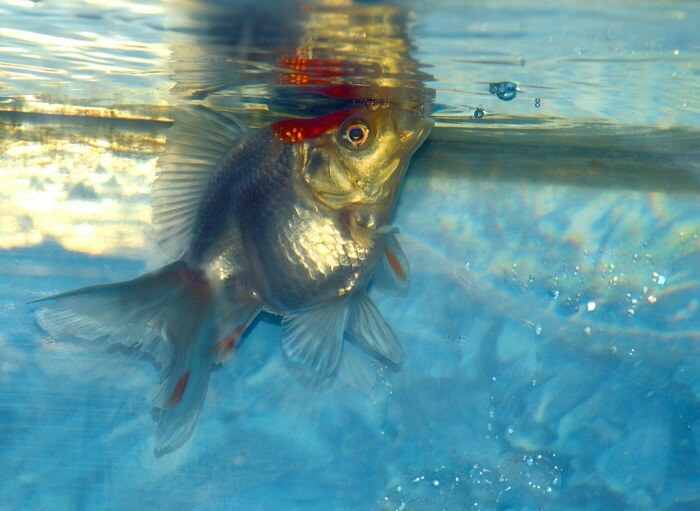
Ryukin Goldfish are Omnivores that will eat quite readily and accept most types of food.
High-Quality dry Flakes or pellets, especially those designed for ornamental Goldfish, or Fancy Goldfish are their primary food source.
Commercial foods ensure that they get enough nutrients and that their meals are completely balanced.
You can however supplement their meals with live or frozen foods every now and again.
Most Round bodied Goldfish are susceptible to digestive issues, thus, feeding them meaty food supplements and some fresh veggies such as algae will keep them healthy.
How Often And How Much Should You Feed
Ryukin Goldfish are quite prone to overeating, which can easily agitate their very sensitive intestinal system.
They should be given two to three small meals per day, and you should give them as much as they can eat within a few minutes only.
Feeding Live Foods
Most Goldfish species that live in ponds often eat insects and even small crustaceans, or insect larvae in their natural habitat.
The problem with Live food for Ryukin Goldfish in tanks is that many live foods from pet stores or even natural sources such as local rivers, and ponds, could contain harmful chemicals, or even parasites.
If you want a trusted source of Live food, rather opt for home brine shrimp obtained from a hatchery.
Frozen foods are ideally a safer option to satisfy the meaty protein requirements of your Ryukin Goldfish.
Temperament And Personality
As you can see from the video, Ryukin Goldfish can be quite active and social, they are an absolute joy to watch and tend to be more on the sturdy side than most fancy Goldfish. Ryukin Goldfish are said to be semi-aggressive, which means that they will pick on smaller and wicker fish, seeing them as potential prey.
Thus, in a nutshell, they are a hardy breed for beginners, they are active, and loads of fun to watch, but you need to be careful what types of tank mates you choose to join them.
Common Health Issues
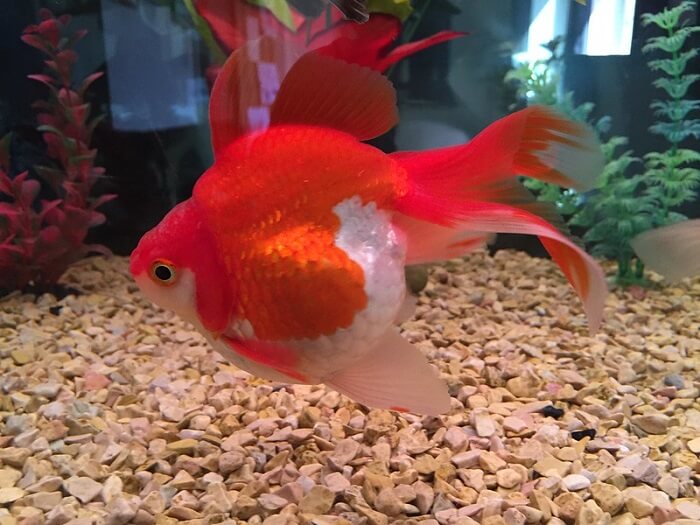
In general Ryukin Goldfish are tough creatures that should not easily suffer any health issues, given that you keep their tank clean, and ensure them a good quality varied diet.
That said, there are still a few common diseases that most Fancy Goldfish are prone to getting;
1. External Parasites
There are External Parasites, as quoted from researchgate.net, a Scientific research site “Various ecto‐parasitic protozoa (e.g. Chilodonella; Ichthyobodo; Trichodina) Skin and fin damage; gill damage and respiratory stress (caused by certain species of parasitic protozoa); secondary infections Argulus (fish‐louse) Skin damage; anemia; secondary infections”
Ich, or Ick is one such parasitic condition caused by a freshwater parasite that mostly attacks weak or stressed fish. New additions to your tank are especially susceptible to Ich. The parasite causes tiny white spots across the body, gills and fins of the fish, that is itchy and irritating to them.
Luckily there are plenty of over-the-counter medications online, and from pet stores that will quickly get rid of these parasites.
Then you also get Flukes and external parasites that will attach to both freshwater and marine fish, some common species include Anchor Worms, Fish Lice, and Skin Flukes. They are often found on new fish, and plants, and can live in fish foods.
Flukes are treated with antiparasitic medication, or salt water can be used to clean off plants. Prevention is obviously better than cure, so try to keep any new fish or plants in a separate tank for at least two weeks, and avoid using live foods.
2. Bacterial Infections
Fish that are weak or stressed out, especially new additions to your tank are at higher risk of bacterial infections.
Bacterial Infections can cause the following signs;
- Skin Ulcerations.
- Slow and Lethargic reactions.
- Fins that have tears or are ripped.
- Decrease in Appetite.
- Inflamed Patches on the skin, and missing scales.
- Panting or difficulty breathing.
Luckily, you do get a broad-spectrum antibacterial medication from most pet stores and online that will work like a charm.
3. Water Quality Problems
The Quality of the water in your tank can cause respiratory stress and Gill Damage. When you notice your fish gulping for air at the top of the tank, there may be low oxygen levels, caused by inadequate aeration, overcrowding, or water pollution. Chlorine in some tap waters and Ammonia buildup from waste can all lead to these issues. In other words, keep your tank clean, test the pH regularly, and avoid tap water with high Chlorine levels.
4. Digestive Disorders
Most Round Bodied Goldfish tend to be more susceptible to digestive disorders, of which Swim Bladder is the most common, and the hardest to cure. Tilted and uncoordinated swimming, as well as a potbelly, are your first signs of Swim Bladder.
Ryukins need a well-balanced diet with commercial food, fresh veggies, and meaty protein to prevent swim bladder. You can read more about swim bladders in the Oranda Goldfish Care guide.
5. Physical Damage
Lastly I would like to add a caution, I have seen quite a few Youtube videos of different types of Goldfish being handled and played with, which is not recommended. Physical handling can damage their skin, and lead to severe infections, not to mention the fact that it is very stressful for the fish to be handled or be out of water.
On the other hand, some of their tank plants and decorations may have sharp edges or rough surfaces that could also cause an injury.
If you think that your Ryukin Goldfish may be sick or maybe showing any warning signs, I highly recommend “Goldfish Behavior Before Death” as more extensive information on how to identify the problem and solve it.
Breeding And Fry Care
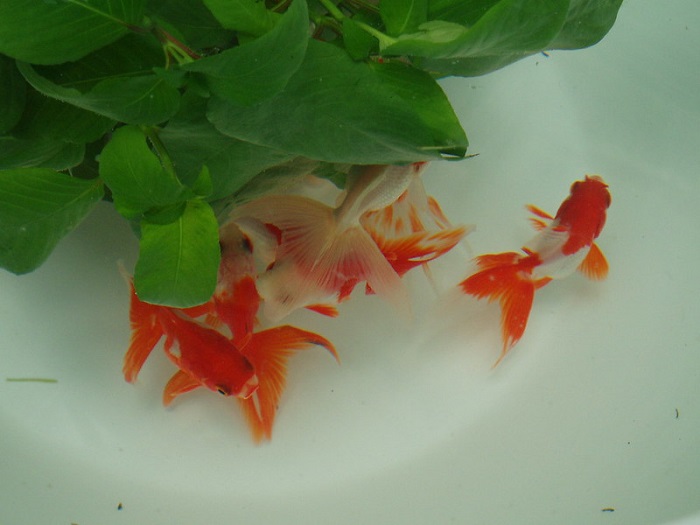
Breeding
When it comes to breeding Ryukin Goldfish, I have good news for you, under the right conditions they are very easy to breed and you could easily end up with thousands of baby fish.
The most ideal way to breed Ryukin Goldfish is in groups, as they are very social creatures. You can easily house a few males and females together to spawn.
To Successfully Breed your Ryukin you can follow these steps;
1. Use A Separate Breeding Tank
You will need to create a separate tank for breeding that is at least 20 gallons. Try to add more fibrous plants that have many leaves such as the Live Anacharis. You can also try out an artificial breeding mop.
2. Spawning In Ryukin
It is best to separate males and females for a few weeks before spawning, and to increase protein-rich foods that will help to improve their mood.
After a few weeks, you can slowly introduce your fish and allow them to acclimate. Drop the water temperature to around 60 degrees Fahrenheit and then gradually increase it to around three degrees every day.
You can still feed a high-protein diet consisting of frozen or live foods until your Ryukin starts to spawn. You will notice your female swelling up before she lays eggs, preferably in the spawning mop or plants. Females can lay up to 10 000 eggs at a time. The male fertilizes the eggs, and this concludes the spawning process.
Caring For The Eggs And Hatchlings
Try to remove all adult Ryukin Goldfish immediately because Ryukin Goldfish tend to eat their eggs after breeding. The eggs will take around seven days to hatch. Hatchlings will enjoy some” powdered dry fish fry food” until they have grown a bit, and then you can add brine shrimp to their diet.
In the video are some adorable baby Ryukin Goldfish, or fry for you to enjoy!
To Conclude
The Ryukin Goldfish is a larger ornamental fancy Goldfish that has a friendly demeanor and a vigorous personality. It is robust and easy to care for Goldfish, one of the easiest in Fancy Goldfish species for Beginners. Under the right conditions and following the right steps in care and feeding your Ryukin and its tank mates will be active, and cheerful fish with boastful personalities and majestic colors and appeal.


